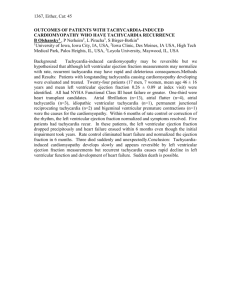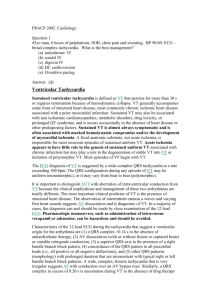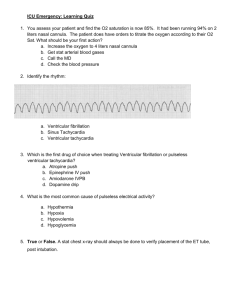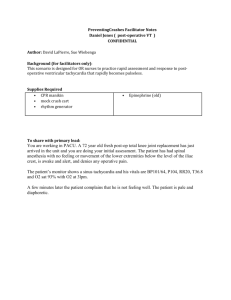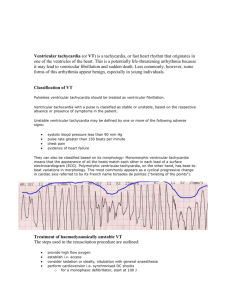EP Study Protocol
advertisement
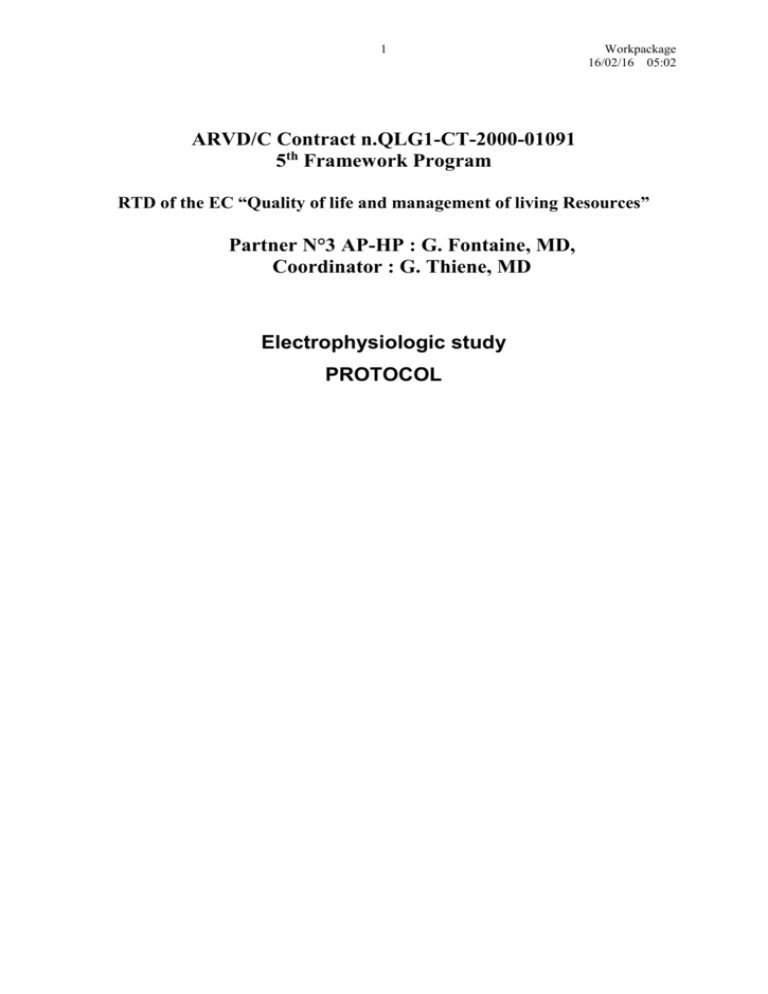
1 Workpackage 16/02/16 05:02 ARVD/C Contract n.QLG1-CT-2000-01091 5th Framework Program RTD of the EC “Quality of life and management of living Resources” Partner N°3 AP-HP : G. Fontaine, MD, Coordinator : G. Thiene, MD Electrophysiologic study PROTOCOL 2 Workpackage 16/02/16 05:02 WORK PACKAGE # 4 Electrophysiologic study Electrophysiologic study (EPS) is an important diagnostic tool for the evaluation of patients with arrhythmogenic right ventricular cardiomyopathies : The purpose of electrophysiologic study is to provides three kinds of documents (1) the basic electrical properties of the heart which may prove to have a diagnostic value (2) the evaluation of risk by demonstrating the induction of ventricular tachycardia which is an important parameter of the disease in terms of prognosis (3) evaluation of drug efficacy by demonstrating the non-inducibility of ventricular tachycardias. These parameters may be influenced by the effect of antiarrhythmic drugs already given to prevent/diminish cardiac arrhythmias. It is not always possible to interrupt this treatment to have a baseline study. Therefore the antiarrhythmic treatment(s) have to be indicated at the date of EPS. 1) Basic Electrical Properties : These properties are evaluated by programmed pacing providing measurements of conduction times and refractoriness at several parts of the conduction system of the heart. The first step is to measure the Basic Cycle Length in sinus rhythm. Recording of His bundle potential should be performed after wisdrawal of exploring bipolar (electrodes 1cm apart) from ventricle to atrium. This catheter is immobilized when the highest His bundle potential is recorded. Basic AV Conduction properties Interval between atrial potential and His bundle potential provides the A-H interval in millisecondes. Interval between His bundle potential and the beginning of the QRS complex recorded on the three standard leads DI-DIII gives the H-V interval in millisecondes. The Wenkebach point in beats/mn is obtained by progressive increase of atrial pacing rate up to the first non conducted beat. Effective Refractory Periods Effective refractory periods are the result of programmed pacing using a premature stimulus with a progressively decreasing interval from le last basic pacing drive given by a series of 8 consecutive stimulations at a predetermined pacing rate. The effective refractory period is obtained when the first potential induced by the premature stimulation is not conducted. The basic pacing rate is optional. We propose the standard value of 500ms. 3 Workpackage 16/02/16 05:02 The effective refractory period of the AV conduction system is obtained when the first premature stimulation delivered in the atrium is followed by a His potentials but not by a QRS complex. The effective refractory period of the His bundle is obtained when the first premature stimulation delivered in the atrium is no longer followed by a His bundle potential. The effective refractory period of the Ventricle is obtained when the first premature stimulation delivered to the ventricle is no longer followed by a QRS complex. The study of retrograde conduction (VA conduction) is obtained by ventricular stimulation at an increasing rate up to the first stimulation not followed by an atrial potential. During EPS it is also possible to perform some pharmacodynamic interventions such as injection of Ajmaline Flecainide or Procainamide to exclude the Brugada Syndrome. 2) Ventricular Tachycardia Induction during electrophysiologic study : Ventricular Tachycardia induction is performed by a stimulating catheter positioned at the Apex of the right ventricle. Stimulation may be performed by programmed stimulation or burst stimulation. This investigation may trigger rapid unstable ventricular rate and even ventricular fibrillation. In our institution the patient is equipped with antero-posterior adhesive large electrodes connected to a stand-by defibrillator. All the equipment for Cardio Respiratory Resuscitation has to be ready to intervene. Ventricular tachycardia is defined by its rate, expressed in beats/min or its period in milliseconds. Ventricular tachycardia is considered as non sustained if it lasts less than 30 seconds and stops spontaneously. Left bundle branch block pattern suggests that tachycardia originates from the right ventricular infundibulum or septum. This form represents the most frequent presentation. There is a right bundle branch block pattern when tachycardia originates on the left side of the heart. The axis could be classified as vertical or right ventricular axis, which generally suggests that the tachycardia originates in the infundibular area. It could have extreme left axis deviation if the tachycardia originates in the diaphragmatic aspect of the right ventricle or the apex. Ventricular tachycardia can be monomorphic if only one morphology is observed at each episode (spontaneous or induced). It could be multiple monomorphic if multiple morphologies 4 Workpackage 16/02/16 05:02 are observed during spontaneous episodes or at the time of the EP study. It could be polymorphic with variations in the amplitude of the QRS complexes showing a torsade de pointes-like pattern. Ventricular tachycardia amplitude and direction could be alternating from beat to beat. The form reporting the result of the EP study should indicate the date when the study has been performed, if the patient was on medication(s) and in that case, the medication(s) have to be indicated, mentioning the generic drug name, the drug code and the total delay dose in mgs. It should also indicate if a pharmacological test using a Na channel blocking agent like flecainide, procainamide or ajmaline has been used to exclude the Brugada syndrome and if the Brugada ECG pattern has been observed or not. The study result should indicate the number of VT elicited by programmed pacing, the basic driven cycles, the coupling of extrastimuli from S1, S2, S3, S4, the site of stimulation which could be RVOT, apex or the left ventricle. When programmed pacing is not able to induce VT, burst stimulation which is to deliver a series of rapid pacing at a rate of 250, during 2 to 3 seconds. If this technique is not sufficient, it is possible to perform isoproterenol infusion. The dose of infusion could be indicated. However, in practice we have observed the sensitivity of patients to isuprel is very variable. Spontaneous sinus rate should increase up to 120 bpm before starting a new VT induction protocol. Ventricular tachycardia morphology has been classified in left BBB, right BBB, V1 to V6 negative QRS, and polymorphic. The form must also include if the tachycardia is, tolerated VT or not. A poorly tolerated VT is the result of a rapid rate necessitating medical intervention. Termination of the tachycardia is also important : It could be spontaneous after drugs, antitachycardia pacing, or DC shock. 3) Evaluation of Drug Therapy: The same previously describe technique of programmed stimulation used to confirm ARVD might be used to evaluate the non-reinducibility of cardiac arrhythmias after drug therapy. The method called “serial testing” is based on the reevaluation of a new drug after failure of a previous antiarrhythmic treatment until arrhythmia control based on its noninducibility. _________


